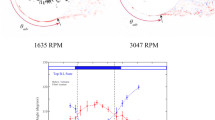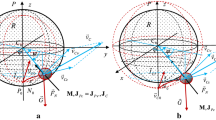Summary
A differential equation is presented accounting for the effect of aerodynamic drag on a falling sphere along with its analytical solution. The resulting expression for the velocity of the ball predicts a terminal velocity of approximately 8 m/s. A falling ping-pong ball was recorded using a high-speed video, and the results correlate well with the analytical prediction.
Similar content being viewed by others
References
Van Dyke, M., An Album of Fluid Motion, Parabolic Press, Stanford, CA (1982).
Abraham, F.F., “Functional Dependence of Drag Coefficient of a Sphere on Reynolds Number,” Physics of Fluids 13(8):2194 (August 1970).
Johnson, T.A., and Patel, V.C., “Flow Past a Sphere Up to a Reynolds Number of 300,” Journal of Fluid Mechanics 378: 17–19 (70).
Liao, S.J., “An Analytic Approximation of the Drag Coefficient for the Viscous Flow Past a Sphere,” International Journal of Non-Linear Mechanics 37(1):1–18 (2002).
Author information
Authors and Affiliations
Rights and permissions
About this article
Cite this article
French, R.M. Part 4: Dropping a ping-pong ball. Exp Tech 30, 59–60 (2006). https://doi.org/10.1111/j.1747-1567.2006.00017.x
Published:
Issue Date:
DOI: https://doi.org/10.1111/j.1747-1567.2006.00017.x




